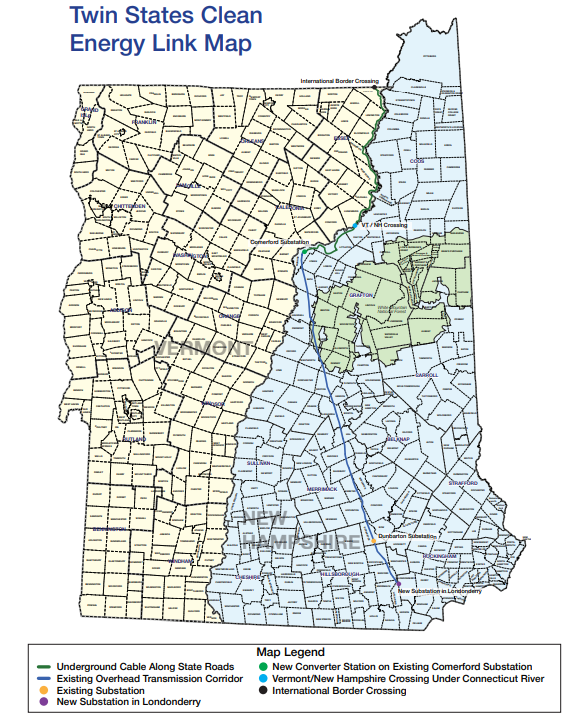Fact sheet link here:
By GARRY RAYNO, InDepthNH.org
CONCORD — A proposed 1,200-megawatt transmission line through Vermont and New Hampshire has been included in a federal program to improve the nation’s electric grid.
The Twin States Clean Energy Link, proposed by National Grid, Citizens Energy Corporation and Northeastern Vermont Development Association, is one of three projects nationwide earmarked for investment under the U.S. Bipartisan Infrastructure Law’s Transmission Facilitation Program.
The US Department of Energy program is a $2.5 billion revolving fund to help upgrade and build new, large-scale transmission lines.
The agency expects the three projects to improve reliability and increase the amount of clean energy on the grid.
The $2 billion Twin State project was reintroduced in May after being dormant for several years and would use existing transmission corridors and line burial under existing roads in both states traversing 211 miles from the Canadian border to Londonderry.
“This is an important step forward for Twin States as we work to make the project a reality for the region,” said Stephen Woerner, New England President, National Grid. “DOE has recognized the significant economic and environmental benefits of this project to New England communities, residents and businesses and we’re grateful for this recognition from our federal partners.”
The project has the support of New Hampshire Gov. Chris Sununu, Vermont Gov Phil Scott and Massachusetts Gov. Maura Healey.
Sununu said Monday morning “Tapping into hydropower resources, the Twin States Clean Energy Link project makes use of clean, renewable energy to deliver the region a reliable energy source with cost savings for consumers. This project is a win for New Hampshire.”
Project officials say the proposed two-way transmission line linking Quebec and the New England grid, will save New England ratepayers $8.3 billion in wholesale market costs over the first 12 years of the project.
While the project was initially designed to bring Quebec Hydro power to the New England market, the new proposal would allow the power to flow both ways so that New England wind power could flow to Quebec when it’s needed.
The project would be one of three intended to deliver Hydro Quebec, a crown company, electricity to the Northeast.
The New England Clean Power Connect in Maine was chosen by Massachusetts after the Northern Pass project through New Hampshire failed to win regulatory approval.
The project was halted after a state referendum passed opposing the plan, but earlier this year a Maine court sided with the developers and found the project could proceed.
However, work on the project has been slow to restart.
The Champlain Hudson Power Express, which connects Quebec with the New York City region is under construction and expected to be operational in May 2026. The $6 billion project goes under Lake Champlain for part of the route.
When electricity costs spiked two years ago at the beginning of the Russian invasion of Ukraine, Northeast utilities sought cheaper Hydro Quebec electricity to offset spikes in wholesale costs.
That coupled with a surge in demand in Quebec had Canadian province officials seeking a review of the export contracts of Hydro-Quebec.
Company officials said earlier this year they intend to expand capacity through additional wind power resources and reassured officials the utility had ample power to both meet the growing demand in Quebec and its export contracts.
The federal program would have the energy department negotiate capacity contracts with National Grid, in the hopes of encouraging private investors to negotiate for capacity on the proposed transmission line as well.
National Grid officials said Monday “Twin States remains subject to finalizing contractual arrangements and investment plans.”
The federal program, which is included in the bipartisan infrastructure legislation pushed by the Biden Administration, also seeks to encourage the development of more clean energy to reduce carbon emissions.
“To realize the full benefit of the nation’s goal of 100 percent clean electricity by 2035, we need to more than double our grid capacity and President Biden’s Investing in America agenda puts us in position to do just that,” said U.S. Secretary of Energy Jennifer M. Granholm.
Unlike Northern Pass, the project would have a converter station in Monroe New Hampshire to convert from direct to alternating current, which reduces the need for the amount of separation between the two types of electricity on transmission towers. That in turn would reduce the need for the very high and highly visible towers the Northern Pass project needed, particularly noticeable in the Concord area.
Most of the line burial for the project would be between the Canadian boarder and the Monroe converter station.
The project is also expected to address the long-standing transmission problem with the Coos Loop, which has limited capacity and does not allow for all of the North Country wind projects to run at maximum capacity.
The Northern Pass project also would have addressed the issue, but improvements were dropped when Eversource decided not to go forward with the project after the state Supreme Court uphold the Site Evaluation Committee’s rejection of the Northern Pass application because project officials could not prove it would not interfere with the orderly development of communities along the route, one of the major criteria for approving or rejecting a utility project.
Garry Rayno may be reached at garry.rayno@yahoo.com.





